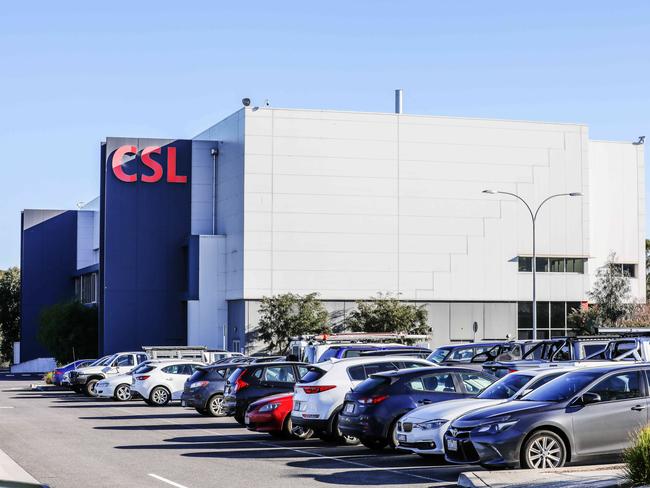First shot of CSL’s haemophilia B-curing and world’s most expensive drug is used
The blockbuster new drug to cure haemophilia with one $3.5m shot has finally made its way to the first patient - boosting hopes for CSL’s $1bn franchise.
A patient in the US has become the first person to receive the world’s most expensive drug, Hemgenix, as CSL begins to commercialise its treatment for haemophilia B.
At $3.5m a shot, Hemgenix aims to effectively cure patients in one dose, replacing regular infusions that can cost more than $20m over an adult lifetime.
Analysts had been anticipating a quicker launch of the drug, which the US Food and Drug Administration approved last November, and initially expected that it would send CSL shares soaring above $300 again.
Part of the reason why commercialisation has been slower than expected is that health funds have been reviewing coverage of Hemgenix on a case-by-case basis.
But CSL has confirmed that more than 60 per cent of the US population has health policies covering the cost of the one-time only gene therapy.
An Australian launch is understood to be several years away, with the drug currently before the Therapeutics Goods Administration.
CSL Behring vice president for North America, Bob Lojewski, highlighted the cost savings to the health system, despite the high upfront price.
“Discussions between CSL Behring and the payer community on the value proposition offered for Hemgenix have been positive, which is reflected in the policies that have been written,” Mr Lojewski said.
“As part of our longtime promise to patients, CSL Behring is thrilled to mark this latest milestone of the first commercial patient having received Hemgenix and look forward to continuing to deliver this paradigm-shifting treatment to the haemophilia B community.”
Haematologist Matthew Ryan administered the first dose of the drug to patient in Wisconsin and said it was a “long-awaited advancement” for people with haemophilia B – a debilitating illness that plagued European royalty in the 19th and early 20th centuries and affects about one in 40,000 males today.
“This exciting treatment offers patients a chance to live a life without frequent bleeds or the burden of regular infusions,” Dr Ryan said.
“The availability of this new one-time treatment also sparks additional conversations in the community when it comes to treatment options and goals, which is extremely important when managing a lifelong condition, as an individual‘s needs can change for a variety of reasons.“

It comes as CSL, Australia’s biggest health company, warned of a profit hit of up to $US250m ($372.3m) this year – citing a strengthening US dollar against major currencies.
The company also expected to deliver earnings of $US2.9-$US3bn next financial year, which was dramatically below consensus estimates of $US3.5bn.
UBS analyst Laura Sutcliffe said a slower launch of Hemgenix was partly why she downgraded her profit forecast for the company by 7 per cent.
“US physician checks by UBS suggest this is down to the need to agree on a case by case basis with both insurers (for payment) and infusion centres (for administration).” Ms Sutcliffe wrote in a note to investors.
“Early trajectory aside, physicians indicated candidates who could potentially benefit are already being identified for 2024 and 2025. We still ultimately expect a blockbuster product (4 per cent of top line in 2030) although now model a shallower FY23 launch curve.”
Goldman Sachs analyst Chris Cooper said it was too early to say what the long-term impact to CSL’s conventional treatment for haemophilia B, Idelvion, will be.
“(But) we do see scope for near-term, at least, upgrades to the haemophilia franchise – 9 per cent of FY24e sales,” Mr Cooper said in a note to investors.
CSL’s haemophilia business generated a 12 per cent rise in revenue last year to $US611m, with the company attributing the gain to higher demand for Idelvion, particularly in Japan. This compared with CSL’s overall revenue leaping 25 per cent to $US7.18bn.
Macquarie cited contributions from CSL’s pipeline products, including Hemgenix, as upside risks to the company’s earnings.
Hemgenix works by injecting a functioning copy of the blood clotting gene into a patient with haemophilia B. Crucially, the one shot replaces a lifetime of fortnightly infusions to control the blood disorder, effectively curing a patient.
It is one of the handful of approved gene therapies that has sparked a wave of drugs priced in the millions of dollars a patient.
The high cost of the drugs — which promise to cure or treat diseases in a single course — has raised eyebrows. After all, big pharma was previously reluctant to charge any more than six figures for a drug.
But patients say the massive expense is worth it, particularly when amortised over their lifetime. It is this rationale health funders need to face as they potentially baulk at paying the handsome fee for these groundbreaking treatments — which have been approved to not only cure blood disorders such as Haemophilia B, but also muscle wasting conditions and rare childhood neurological diseases.







To join the conversation, please log in. Don't have an account? Register
Join the conversation, you are commenting as Logout